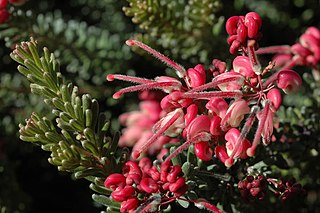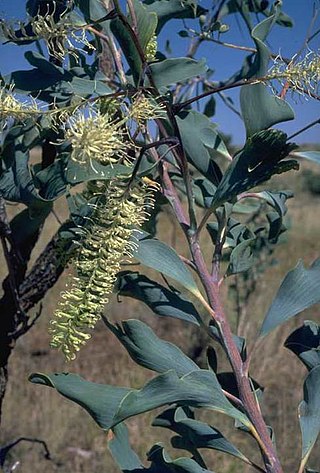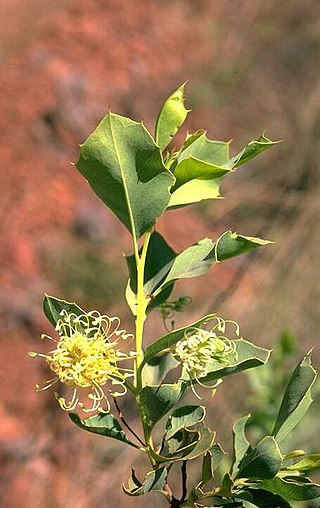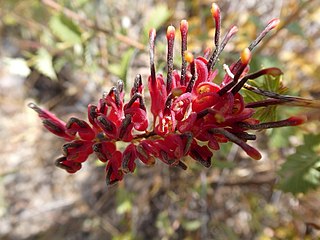
Grevillea lanigera, commonly known as woolly grevillea, is a species of flowering plant in the family Proteaceae and is endemic to south-eastern continental Australia. It is a spreading shrub with narrowly oblong to more or less linear leaves and clusters of pink to red, and cream-coloured flowers.

Grevillea intricata is a species of flowering plant in the family Proteaceae and is endemic to the west of Western Australia. It is a densely-branched shrub with tangled branchlets, divided leaves with linear lobes and clusters of pale greenish-white to light cream-coloured flowers.

Grevillea umbellulata is species of flowering plant in the family Proteaceae and is endemic to the south-west of Western Australia. It is a spreading shrub that forms a lignotuber, has linear to narrowly elliptic leaves, and cylindrical clusters of hairy, white to cream-coloured flowers often tinged with grey or pink.

Grevillea concinna, commonly known as red combs or elegant grevillea, is a species of flowering plant in the family Proteaceae and is endemic to the south-west of Western Australia. It is a spreading to erect shrub with mostly linear to narrow wedge-shaped leaves sometimes with a sharp point on the tip. Flower colour varies with subspecies.

Grevillea venusta, commonly known as Byfield spider flower, is species of flowering plant in the family Proteaceae and is endemic to a small region of central eastern Queensland. It is an erect shrub with simple and/or divided leaves, the leaves or lobes narrowly oblong to narrowly elliptic, and clusters of green and yellow flowers with a deep maroon to purplish black style covered with white hairs.

Grevillea australis, commonly known as alpine grevillea or southern grevillea, is a species of flowering plant in the family Proteaceae and is endemic to south-eastern Australia. It is a spreading to prostrate shrub with simple, narrowly egg-shaped leaves and groups of white to pale pink flowers with a glabrous ovary.

Grevillea ilicifolia, commonly known as holly grevillea or holly bush, is a species of flowering plant in the family Proteaceae and is endemic to southern continental Australia. It is a spreading to prostrate shrub with holly-like leaves with sharply-pointed triangular to egg-shaped teeth or lobes, and clusters of green to cream-coloured and mauve flowers with a pink to red style.

Grevillea pulchella, commonly known as beautiful grevillea, is a species of flowering plant in the family Proteaceae and is endemic to the southwest of Western Australia. It is a spreading shrub usually with pinnatisect leaves, and cylindrical clusters of white to cream-coloured flowers.

Grevillea refracta, commonly known as silver-leaf grevillea, is a species of plant in the protea family and is native to northern Australia. It is a tree or shrub usually with pinnatipartite leaves and red and yellow flowers arranged on a branched, downcurved raceme.

Grevillea dryandri is a species of flowering plant in the family Proteaceae and is endemic to northern Australia. It is a spreading to erect shrub with divided leaves with up to seventy or more linear to narrowly elliptic leaves, and long clusters of red, orange-red, pink or white flowers.

Grevillea dimidiata, also known as the caustic bush or willings tree, is a species of flowering plant in the family Proteaceae and is endemic to northern Australia. It is a shrub or small tree with glabrous, more or less sickle-shaped, curved leaves with wavy edges, and cylindrical groups of greenish-white to cream-coloured flowers.
Grevillea murex is a species of flowering plant in the family Proteaceae and is endemic to a relatively small area of south-western Western Australia. It is a spreading, much-branched shrub with hand-shaped leaves and clusters of greenish-white to dull cream-coloured flowers.

Grevillea myosodes is a species of flowering plant in the family Proteaceae and is endemic to north-western Australia. It is a spreading shrub with elliptic leaves and branched clusters of cream-coloured flowers.

Grevillea occidentalis is a species of flowering plant in the family Proteaceae and is endemic to the south of Western Australia. It is a spreading to erect shrub with linear to narrowly egg-shaped or narrowly elliptic leaves and grey or off-white flowers.

Grevillea prasina is a species of flowering plant in the family Proteaceae and is endemic to north-western Australia. It is a spreading or straggly shrub with egg-shaped to elliptic leaves with coarsely-toothed edges, and dense, cream-coloured to pale yellow flowers, the style pale green to white.

Grevillea trifida is species of flowering plant in the family Proteaceae and is endemic to the southwest of Western Australia. It is a spiny, erect to low spreading shrub, usually with divided, variably-shaped leaves, and clusters of white to cream-coloured flowers.
Grevillea dunlopii is a species of flowering plant in the family Proteaceae and is endemic to the northern part of the Northern Territory. It is a spreading shrub with divided leaves with nine to seventeen spreading lobes, and pale cream-coloured to white flowers.

Grevillea goodii, also known as Good's grevillea, is a species of flowering plant in the family Proteaceae and is endemic to the Northern Territory. It is a prostrate shrub with egg-shaped to narrowly elliptic leaves and clusters of light green flowers with a pink to red style.

Grevillea montana is a species of flowering plant in the family Proteaceae and is endemic to a restricted to a small area of eastern New South Wales. It is a dense shrub with narrowly elliptic to lance-shaped leaves and bright green and pinkish-red flowers.

Grevillea pungens, also known as flame grevillea, is a species of flowering plant in the family Proteaceae and is endemic to the Northern Territory in Australia. It is a shrub with egg-shaped leaves with rigid, sharply-pointed teeth or lobes, and hairy, deep pink to orange flowers.



















